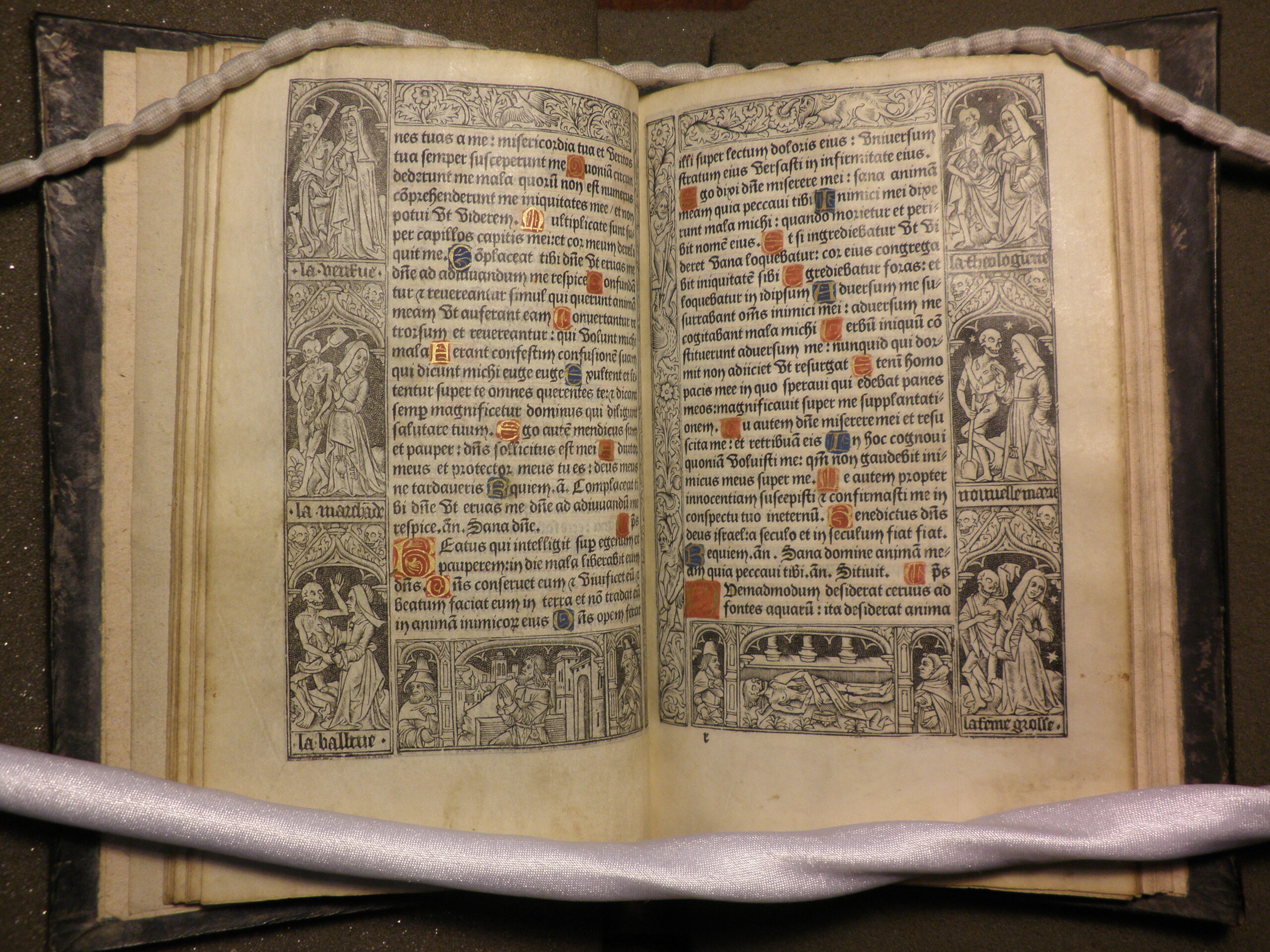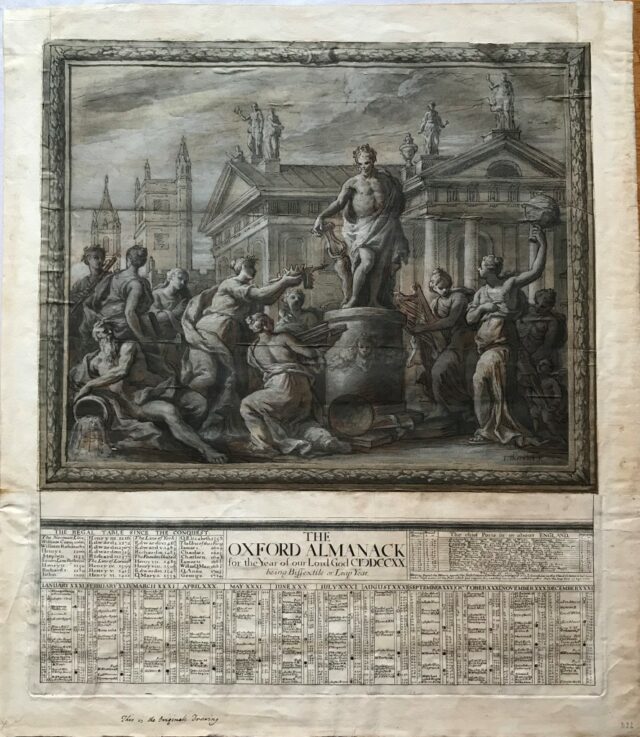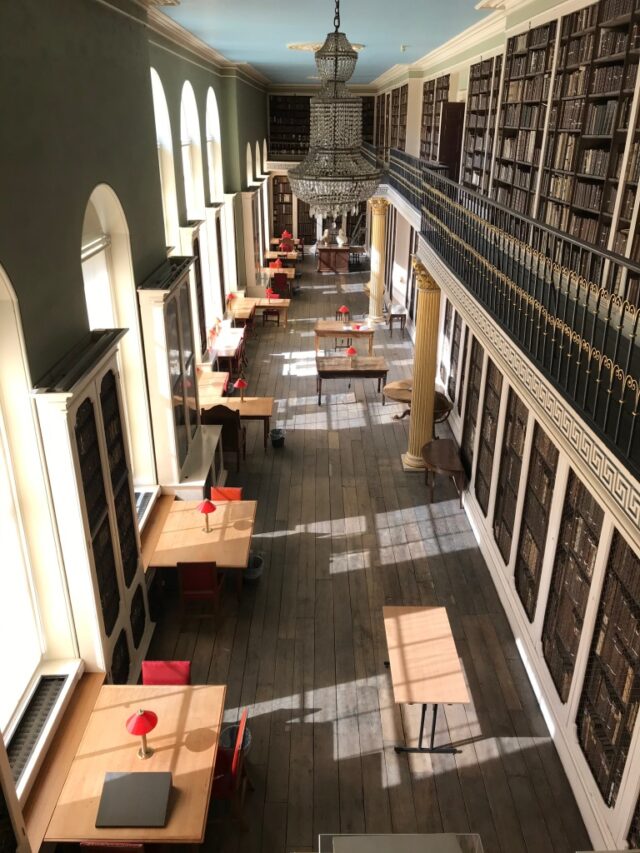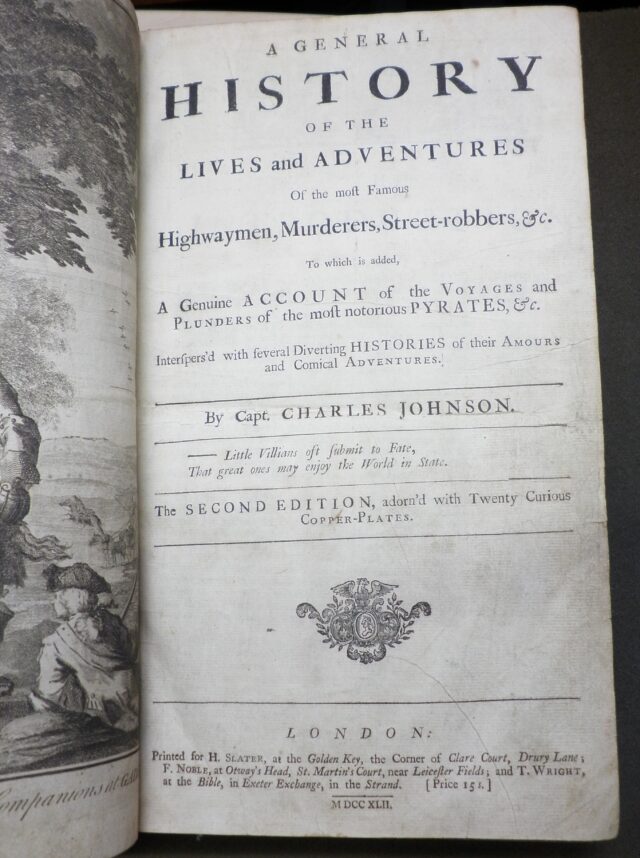Dances of Death: The Office of the Dead with a set of woodcut ‘cards’

02nd November 2018
Dances of Death: The Office of the Dead with a set of woodcut ‘cards’

Fragment of the Office of the Dead, consisting of 13 leaves of vellum, from a Book of Hours for the use of Rome [Paris: Philippe Pigouchet for Simon Vostre, c. 1496-7] Together with a set of woodcuts featuring the Dance of Death.
We have been doing much with the Library’s collection of incunabula (15th-century printed books) recently. Following on from our participation in the Material Evidence in Incunabula (MEI) cataloguing project, which saw almost all of the College’s 31 incunabula recorded in the MEI database (see https://data.cerl.org/mei/_search), we have held exhibitions for Old Members in August and participated in the ‘Initial Impressions’ incunabula trail with six other Oxford Colleges in October. One incunable which attracted particular attention is a fragment of 13 leaves of illustrated vellum from a French Book of Hours made for the use of Rome. The printed text is the Office of the Dead, which as the proper reading for All Souls’ Day, 2nd November, makes it a fitting choice for a blog post published on that date.

First page of the Office of the Dead
Books of Hours, volumes containing appropriate psalms and short hymns for the eight daily occasions of devotion to the Virgin, were probably the most common manuscripts of the Middle Ages, and so it is hardly surprising that Books of Hours should be among the first printed books (see Dondi, Printed books of hours from 15th-century Italy, page 7). The Worcester fragments contain the Office of the Dead in Latin, the recital of which over a dead person’s coffin was believed to reduce the time the soul would spend in Purgatory (see Clemens and Graham, Introduction to manuscript studies, page 217). It is a work of beauty, black ink printed on vellum with red, blue and gold illumination of capitals.

Double opening from the Office of the Dead
The printed pages have extensive and intricate woodcut borders, all featuring Death as a skeleton. Indeed, they represent the Dance of Death: a series of mortals, arranged in hierarchical order, are summoned by Death to join his dance. The power of Death and the equality of all before him is powerfully expressed. The language and style of the woodcuts suggests a French place of production, and these fragments are thought to come from a Book of Hours printed in Paris around 1496-1497 by Simon le Vostre (see Rhodes, A catalogue of incunabula…, no. 937). This Dance of Death series in the borders of the volume can be compared with a set of woodcuts shelved with this volume.
Kept inside the Office of the Dead volume are a near complete set of 44 woodcuts illustrating the Dance of Death. With images measuring 67 x 55 mm (along the bold outer frame) at first sight they resemble playing cards. The visual language of these images is much more extensive than that found in the borders of the Office of the Dead, where only two standing individuals are ever depicted, Death and the dying. For example, we can compare the representation of the ‘Advocate’: whilst the woodcut border of the Office of the Dead simply shows a skeletal Death interrupting the advocate on a path, in the ‘card’ woodcut, four figures are represented. Here Death, holding up the hourglass, interrupts a commercial transaction between the advocate and a well-dressed man. A fourth figure, clasping his hands in prayer, looks on, inviting us to witness the corruption taking place openly in the town square (see Rublack, The dance of death, page 159).
In their composition and storytelling the ‘cards’ copy the Pictures of Death by Hans Holbein the Younger (c. 1497- 1543). His particularly famous series of Dance of Death woodcuts were completed in 1526, and first published in book form as Les Simulachres & historieés faces de la Mort in Lyon, by the Techsel brothers, in 1538. They are known for their variety, both in backdrops (architectural exteriors and interiors) and in the figure of Death (three times presented as a woman: in the woodcuts of the Empress, Queen and Nun). The hourglass is a common feature of Holbein’s Dance of Death, which are intricate designs telling a story in a single image. This Worcester set appear to be imitations of Holbein. But can we say more?

Dance of Death card: The Merchant
Although they may at first sight appear like playing cards, the Worcester woodcuts are printed on both sides of the paper (i.e. on recto and verso), with the verso image immediately following the recto image according to the traditional sequence; so, for example, the ‘Empress’ who traditionally follows the ‘Cardinal’, is printed on the reverse of the ‘Cardinal’ image. Each woodcut has an English title and Biblical quotation and the remnants of further English text underneath the image is visible in some cases (e.g. ‘The Merchant’), suggesting that they have been cut from their original setting. This manner of printing looks suspiciously like a book, and one printed for an English audience.
In the course of writing this piece, I have made the tentative identification of the Worcester set with a duodecimo volume printed in 1789 by T. Hodgson in London: Emblems of mortality; representing, in upwards of fifty cuts, death seizing all ranks and degrees of people… (ESTC record at http://estc.bl.uk/T139829), a digitized version of which is available at https://babel.hathitrust.org/cgi/pt?id=uiuc.2511220;view=1up;seq=71. The Worcester images correspond well with those in Hodgson’s publication, all faithfully copying the Holbein originals except the first, where an image of God in the Pope’s habit has been ‘scrupulously exchanged for another design’ (Douce, Holbein’s Dance of Death, page 105). Further correspondence can be found in the text just visible underneath the Worcester ‘Merchant’, which matches that in Hodgson’s edition. The frontispiece to Hodgson’s publication has even been glued to the folded paper in which these woodcuts are preserved. Based on this identification, the woodcuts are the work of John Bewick (bap. 1760, d. 1795) of Newcastle upon Tyne. From a Librarian’s perspective, we have here a true Halloween horror: a dismembered book, mutilated to focus on the illustrations.

Frontispiece for the Dance of Death cards
This vandalism did, I feel sure, take place before the book entered Worcester College Library. Given the similar subject matter between these cuttings and the Office of the Dead volume with which they have always been kept, it is likely that they were bought with it, when the volume was purchased by H. A. Pottinger, Librarian 1884-1911 (his stamp can be found on the front endpaper). There is no record of this sale, however, so this must remain a mere hypothesis, although one hopes for the discovery of a sales catalogue one day. Some further work also remains to be undertaken: the measurements of the type do not quite correspond with the copies of Hodgson I have been able to consult. I hope, therefore, to compare it soon with a copy of the edition of the same woodcuts published in Newcastle by William Charnley in 1789 (see http://estc.bl.uk/N30049). Nonetheless, in taking some time to look further at these woodcuts, we have added a little to the Library’s knowledge of this item.
Mark Bainbridge, Librarian
Note: at present the record for the Office of the Dead is not live on the MEI database. Further research is being undertaken to understand more about this volume.
Bibliography
- Clemens, R. and T. Graham, Introduction to manuscript studies (Ithaca, NY: Cornell University Press, 2007)
- Dondi, C., Printed books of hours from fifteenth-century Italy (Florence: Leo. S. Olschki, 2016)
- Douce, F., Holbein’s Dance of Death exhibited in elegant engravings on wood (London: Henry G. Bohn, 1858)
- Rhodes, D. E., A catalogue of incunabula in all the libraries of Oxford University outside the Bodleian (Oxford: Clarendon Press, 1982)
- Rublack, E. (ed) The dance of death (London: Penguin, 2016)











